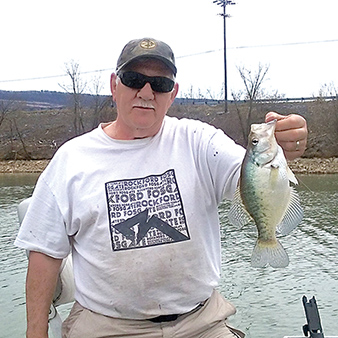Believe me; I’m not suggesting that anyone have a bad or crappy time but rather now is the time to begin your search for some good crappie fishing. I know it’s the beginning of trout season, and I have been putting my share of time on the trout streams as well, but I’ve also been out chasing crappies. Spring is one of the best times to pursue crappies; that’s not to say that you can’t catch your fair share at other times of the year — you certainly can — but spring is high on the list.
Obviously, us ice-fishing types catch crappies all winter long in deep water but in spring crappies move into shallower water in search of spawning areas, and they become easier targets. When I say shallow water, I’m talking about depths in the eight to ten-foot range or even less. I have taken dark colored spawning male crappies in weedy lake edges as shallow as one foot.
Another feature to look for when hunting spring crappies is structure, particularly wood structure. I’m talking about stumps or trees that stick up out of the water, but trees that have fallen into the lakes shore can also be excellent places to locate crappies. Even wood structure that doesn’t make it to the surface is an excellent place to look for crappies — maybe even a better place because the structure is hidden beneath the surface, therefore, fewer anglers find and fish such locations. While some lakes may not have much in the way of natural wood structure, they may have manmade structure. Actually, some of my best crappie fishing has been in and around manmade structure placed at various locations-some submerged and some sticking up through the surface. Don’t neglect the manmade submerged structure since it can be a top producer. Many lakes that have manmade structures placed in them also have maps showing where that structure is located.
In lakes where no visible structure of any kind is available, try fishing areas where sudden depth changes occur. I know of a couple of lakes that have the remains of some old roadbeds; where the edge of the submerged roadbed drops off several feet deeper is a good place to find crappies. A key to finding crappies where no visible structure is available is your depth finder. I will often troll with a few rods out while I carefully scrutinize my depth finder in search of suspended schools or any depth changes that might attract fish. In the meantime, while watching my depth finder any hits on the trolled rods will also point to locations that deserve greater attention.
As to what gear is best for crappie fishing I would definitely go with an ultralight light open-faced spinning reel and a medium action rod of around seven or seven and a half feet. I use two to four-pound test line; it can be a problem sometimes in the brush so you may have to go a bit heavier. There’s no doubt about it, small minnows will produce, but you have to acquire them, transport them, keep them alive and keep them fresh on the hook — that’s a lot of trouble. I can probably catch as many crappies on a simple sixteenth or one eighth once lead jighead and a white Berkley Power Grub as I can on any other rig-maybe even more since I don’t have to keep putting new bait on and I can cover a lot more water and more different depths. A small split-tail jig on a tiny lead jighead suspended several feet beneath a small bobber can also be useful once you’ve determined where a school is located. I wouldn’t rule out a small spinnerbait either — it’s a great search lure since you can quickly cover a lot of different water.
One of my favorite techniques is to locate near some wood structure and then simply flip my small jig and grub combo next to the wood and let it fall on a tight line; a tight line is important since I know immediately if I get a hit-set the hook right away.





Leave a Comment
Your email address will not be published. Required fields are marked with *